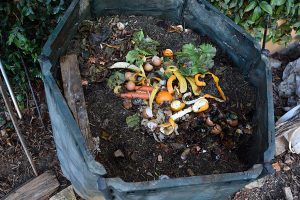By DEBORAH G. SCANLON
The environmental merits of composting food waste are significant: send less garbage to the dump; generate less of the potent greenhouse gas methane; and use less water and fertilizer in your garden. Add to that how much your garden crops will benefit and yield, and it becomes clear that composting is well worth the effort.
I have “quasi-composted” for about 30 years, simply tossing food scraps into a bin to keep trash out of Falmouth’s waste management facility, but with more work, and guidance from knowledgeable gardeners and composters, I plan to reap all the benefits of composting.
Kathryn and Brian Elder of West Falmouth have been composting for years. “I can’t see letting all that rich organic material leave my yard,” Ms. Elder said. “Compost is a gardener’s gold.” She originally had a pile in the open air, but then realized “I was just feeding the animals (including our dog)” and moved on to the black bins purchased through the Cape Cod Cooperative Extension.”
What kind of compost bin should you use?
“In the last year I discovered the metal ash cans at Eastman’s that have about one-inch holes all over,” Ms. Elder said. “These are used for burning but work very well for our kitchen scraps and keep the critters out. I have even ventured to put fish carcasses in there and you should see the pile break down after that—would be cool to have a time lapse, but that really gets it going. Not great if you have the piles too close to living spaces but it goes down quickly. Then, when the material has degraded to something unrecognizable, I pitch fork the stuff into the other black bins with the cone on the top where I place all the garden and yard materials like weeds and clippings.”
Mary Bunker Ryther owns Compost with Me in West Falmouth, the company that picks up food wastes from residences and businesses and converts them into compost.
She said that “in general terms, I prefer sit-on-the ground pile/bin composting rather that tumblers and drums.”
“I recommend making your own bin by forming a 30-inch diameter cylinder out of half inch hardware cloth. Fasten it with carabiner clips so it can be easily opened for mixing, moving, or re-sizing. Keep rodents from digging into the pile from underneath by putting a piece of hardware cloth on the ground first. Make a wire top for it or find a trash can lid to fit, and you’re done. (You can definitely buy the hardware cloth and carabiners at Eastman’s.)”
She cautions that “before choosing a composting product or method I suggest a person or family think about what their expectations and limitations are. I think it’s safe to say that successful home composting is more work than many people expect. As it happens, I’ve acquired and re-homed several composters from customers who gave up on them for various reasons, difficult operation being one of the main culprits. The tumbler-style composters can become hard to operate when filled with heavy, damp material. They may take a lot of strength to crank to move the compost around inside. I’ve found the sliding doors and hatches used to feed or aerate the bins also stick as the equipment ages and weathers.”
Compost bins can be bought at Eastman’s and Mahoney’s and other local stores, and some towns sell them at their waste management facilities.
Is it necessary to stir the contents of your composter?
Ms. Elder said she does not stir it in the winter “unless a critter (e.g., rat or vole) has moved in. They will move in unless you have a metal can due to a perfect situation of warmth and constant food supply.”
Ms. Ryther said home compost does not need to be stirred or mixed in the winter, but if temperatures are warm, then stirring will be beneficial. And she added that “In the winter almost all home compost will freeze with the exception of a pile directly in contact with the ground.”
So what can go in the compost?
“You might want to dispel the myth that certain foods can’t be composted,” Ms. Ryther said. “The critical thing is to determine what foods are appropriate to compost at home and in one’s specific compost set-up. For example, fish composts extremely well, but it may stink if not mixed with ample amounts of carbon material. Fish are also likely to attract scavengers, which most folks don’t want in their backyards.

Photo By Deborah G. Scanlon
“People frequently tell me they’ve heard you can’t compost eggshells or orange peels, or bread, or pasta, etc., which is simply not true. The bread and pasta might attract critters to an unfenced compost area, and for that reason they may be inappropriate for the backyard composter.”
“Shredded paper can go in the compost. It is a great source of carbon. I recommend only putting food grade cardboard, such as pizza boxes, in the compost. Shipping boxes usually have tape (often with fiberglass reinforcing) on them, which you don’t want in your compost.”
She noted that compostable tableware may not break down in a timely way in home compost piles, but there is no harm in putting it in your pile.
“Compost is where the worms thrive,” Ms. Elder said. “Don’t forget to put your eggshells in there as they need calcium to make their egg cases.” She added that it is important to have a balance of moisture in the compost bin. Her bin with food waste can get too wet and the one with garden waste can get too dry so mixing these up and watering a dry pile speeds the process up considerably.
If this all sounds intimidating, Ms. Ryther can help. Starting this fall, Compost With Me will offer a home compost maintenance and troubleshooting service to help DIY composters properly care for their backyard compost piles.

